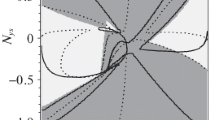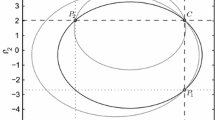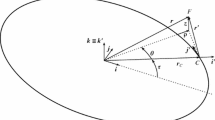Abstract
We present a new method for computing orbits in the perturbed two-body problem: the position and velocity vectors of the propagated object in Cartesian coordinates are replaced by eight orbital elements, i.e. constants of the unperturbed motion. The proposed elements are uniformly valid for any value of the total energy. Their definition stems from the idea of applying Sundman’s time transformation in the framework of the projective decomposition of motion, which is the starting point of the Burdet–Ferrándiz linearisation, combined with Stumpff’s functions. In analogy with Deprit’s ideal elements, the formulation relies on a special reference frame that evolves slowly under the action of external perturbations. We call it the intermediate frame, hence the name of the elements. Two of them are related to the radial motion, and the next four, given by Euler parameters, fix the orientation of the intermediate frame. The total energy and a time element complete the state vector. All the necessary formulae for extending the method to orbit determination and uncertainty propagation are provided. For example, the partial derivatives of the position and velocity with respect to the intermediate elements are obtained explicitly together with the inverse partial derivatives. Numerical tests are included to assess the performance of the proposed special perturbation method when propagating the orbit of comets C/2003 T4 (LINEAR) and C/1985 K1 (Machholz).





Similar content being viewed by others
Notes
The secular terms are completely removed if, in addition to properly prescribing the variation of \(t_0\), we include in the state vector the difference between the true anomalies of the current position at time t and of the departure point at time \(t_0\). The drawback of this approach is that the formulation becomes singular when the angular momentum vanishes, and therefore, it is not universal.
This result for \(\rho \) with \(\kappa =h\) is called Binet’s formula, after Jacques Binet (1786–1856), and it was already known to Isaac Newton (1642–1726).
With the adjective orbital, we mean that the reference frame is defined by the osculating plane of motion, and more specifically that one axis has the same direction of the angular momentum vector.
In Baù et al. (2015) the elements \(\wp _1\), \(\wp _2\), \(\lambda ^{-1}\) are denoted by \(\lambda _1\), \(\lambda _2\), \(\lambda _3\), respectively, and the independent variable \(\chi \) by \(\varphi \).
In Baù et al. (2016) the elements \(\wp _1\), \(\wp _2\), \(-\lambda ^{-1}\) are denoted by \(\lambda _1\), \(\lambda _2\), \(\lambda _3\), respectively, and the independent variable \(\chi \) by \(\varphi \).
Unfortunately, the secular terms are not completely removed since they are contained in the expression of \({\dot{t}}_0\) (see Battin 1999, pp. 510, 511).
Note that the terms with \(\chi ^3\), which stem from \({\tilde{U}}_5\), \(U_5\), cancel out.
These terms contain the product of a trigonometric function of \(\chi \) and some power of \(\chi \).
The time \(t_*\) is usually chosen as the average of the observation times.
In fact, it can be shown that \(rd=2c^2u_1^2\left( \frac{1}{2}\chi ;\bar{\alpha }\right) /\sin ^2\frac{\nu }{2}\).
References
Allan, R.R., Ward, G.N.: Planetary equations in terms of vectorial elements. Math. Proc. Camb. Philos. Soc. 59(3), 669–677 (1963)
Amato, D., Baù, G., Bombardelli, C.: Accurate orbit propagation in the presence of planetary close encounters. Mon. Not. R. Astron. Soc. 470(2), 2079–2099 (2017)
Amato, D., Bombardelli, C., Baù, G., Morand, V., Rosengren, A.J.: Non-averaged regularized formulations as an alternative to semi-analytical orbit propagation methods. Celest. Mech. Dyn. Astron. 131(5), 21 (2019)
Battin, R.H.: Astronautical Guidance. McGraw-Hill Inc, New York (1964)
Battin, R.H.: An Introduction to the Mathematics and Methods of Astrodynamics. AIAA Education Series, revised edn. AIAA, Reston, VA (1999)
Baù, G., Urrutxua, H., Peláez, J.: Edromo: an accurate propagator for elliptical orbits in the perturbed two-body problem. Adv. Astronaut. Sci. 152, 379–399 (2014). Proceedings of the 24th AAS/AIAA Space Flight Mechanics Meeting, January 26-30, 2014, Santa Fe, New Mexico
Baù, G., Bombardelli, C., Peláez, J., Lorenzini, E.: Non-singular orbital elements for special perturbations in the two-body problem. Mon. Not. R. Astron. Soc. 454(3), 2890–2908 (2015)
Baù, G., Milani, A., Bombardelli, C., Amato, D.: New orbital elements for accurate orbit propagation in the Solar System. https://indico.esa.int/event/111/contributions/288/attachments/418/463/PaperICATT.pdf, presented at the 6th International Conference on Astrodynamics Tools and Techniques, 14–17 March 2016, Darmstadt (2016)
Bohlin, K.: Note sur le probléme des deux corps et sur une intégration nouvelle dans le probléme des trois corps. Bull. Astron. 28, 113–119 (1911)
Bond, V.R.: The uniform, regular differential equations of the KS transformed perturbed two-body problem. Celest. Mech. 10, 303–318 (1974)
Born, G.H., Christensen, J., Seversike, L.K.: Special perturbations employing osculating reference states. Celest. Mech. 9, 41–53 (1974)
Broucke, R.A.: Regularized special perturbation techniques using Levi-Civita variables. In: 3rd and 4th Aerospace Sciences Meeting, American Institute of Aeronautics and Astronautics, paper 66-8 (1966)
Broucke, R.A., Cefola, P.: On the equinoctial orbit elements. Celest. Mech. 5, 303–310 (1972)
Broucke, R.A., Cefola, P.: A note on the relations between true and eccentric anomalies in the two-body problem. Celest. Mech. 7, 388–389 (1973)
Broucke, R.A., Lass, H.: On redundant variables in Lagrangian mechanics, with applications to perturbation theory and KS regularization. Celest. Mech. 12(3), 317–325 (1975)
Burdet, C.A.: Theory of Kepler motion: the general perturbed two body problem. Zeitschrift für angewandte Mathematik und Physik 19, 345–368 (1968)
Burdet, C.A.: Le mouvement Keplerien et les oscillateurs harmoniques. Journal für die reine und angewandte Mathematik 238, 71–84 (1969)
Chelnokov, Y.N.: Application of quaternions in the theory of orbital motion of a satellite. I. Cosm. Res. 30(6), 612–621 (1992)
Chelnokov, Y.N.: Application of quaternions to artificial satellite orbital motion. II. Cosm. Res. 31(3), 231–240 (1993)
Crawford, D.F.: Two-body perturbation matrix. AIAA J. 7(6), 1163–1164 (1969)
Danby, J.M.A.: Fundamentals of Celestial Mechanics, 2nd edn. Willmann-Bell, Richmond, VA (1992)
Deprit, A.: Concerning Kustaanheimo-Stiefel’s Regularization. Zeitschrift für angewandte Mathematik und Physik 19, 369–372 (1968)
Deprit, A.: Ideal elements for perturbed Keplerian motions. J. Res. Natl. Bureau Standards 79B (Math. Sci.)(1-2):1–15 (1975)
Deprit, A., Elipe, A., Ferrer, S.: Linearization: Laplace vs Stiefel. Celest. Mech. Dyn. Astron. 58(2), 151–201 (1994)
Der, G.J.: An elegant state transition matrix. J. Astron. Sci. 45(4), 371–390 (1997)
Everhart, E., Pitkin, E.T.: Universal variables in the two-body problem. Am. J. Phys. 51(8), 712–717 (1983)
Ferrándiz, J.M.: A general canonical transformation increasing the number of variables with application in the two-body problem. Celest. Mech. 41, 343–357 (1988)
Goldstein, H.: Classical Mechanics, 2nd edn. Addison-Wesley, Reston, VA (1980)
Goodyear, W.H.: Completely General closed-form solution for coordinates and partial derivatives of the two-body problem. Astron. J. 70(3), 189–192 (1965)
Goodyear, W.H.: A general method for the computation of Cartesian coordinates and partial derivatives of the two-body problem. Tech. Rep. CR-522, NASA (1966)
Hansen, P.A.: Auseinandersetzung einer zweckmässigen Methode zur Berechnung der absoluten Störungen der kleinen Planeten. Abhandlungen der Königlich Sächsischen Gesellschaft der Wissenschaften 5, 41–218 (1857)
Herrick, S.: “Nearly parabolic” and “nearly rectilinear” orbits. Astron. J. 51, 123 (1945)
Herrick, S.: Tables for Rocket and Comet Orbits. U. S. National Bureau of Standards, Applied Mathematics Series, 20, Washington, D. C (1953)
Herrick, S.: Positions, velocities, ephemerides referred to the dynamical center. Astrodynamical report, No. 7, TN-60-773, Air Force Office of Scientific Research (1960)
Herrick, S.: Universal variables. Astron. J. 70(4), 309–315 (1965)
Herrick, S.: Astrodynamics. Von Nostrand Reinhold, London (1971)
Junkins, J., Akella, M.R., Alfriend, K.T.: Non-Gaussian error propagation in orbital mechanics. J. Astron. Sci. 44(4), 541–563 (1996)
Kustaanheimo, P.: Stiefel EL (1965) Perturbation theory of Kepler motion based on spinor regularization. Journal für die reine und angewandte Mathematik 218, 204–219 (1965)
Lara, M.: Note on the ideal frame formulation. Celest. Mech. Dyn. Astron. 129, 137–151 (2017)
Marsden, B.G., Sekanina, Z., Yeomans, D.K.: Comets and nongravitational forces. V. Astron. J. 78(2), 211–225 (1973)
Milani, A., Gronchi, G.F.: Theory of Orbit Determination. Cambridge University Press, New York (2010)
Milanković, M.: O upotrebi vektorskih elemenata u računu planetskih poremećaja. Glas SAN, Beograd CLXXXI:1–72 (1939)
Peláez, J., Hedo, J.M., de Andrés, P.R.: A special perturbation method in orbital dynamics. Celest. Mech. Dyn. Astron. 97(2), 131–150 (2007)
Pitkin, E.T.: A regularized approach to universal orbit variables. AIAA J. 3, 1508–1511 (1965)
Pitkin, E.T.: Integration with universal variables. AIAA J. 4(3), 531–534 (1966)
Roa, J.: Regularization in Orbital Mechanics. Theory and Practice. De Gruyter, Berlin, Boston (2017)
Roa, J., Kasdin, N.J.: Alternative set of nonsingular quaternionic orbital elements. J. Guid. Control Dyn. 40(11), 2737–2751 (2017)
Roa, J., Peláez, J.: Orbit propagation in Minkowskian geometry. Celest. Mech. Dyn. Astron. 123(1), 13–43 (2015)
Roa, J., Peláez, J.: The theory of asynchronous relative motion I: time transformations and nonlinear corrections. Celest. Mech. Dyn. Astron. 127(3), 301–330 (2017a)
Roa, J., Peláez, J.: The theory of asynchronous relative motion II: universal and regular solutions. Celest. Mech. Dyn. Astron. 127(3), 343–368 (2017b)
Rosengren, A.J., Scheeres, D.J.: On the Milankovitch orbital elements for perturbed Keplerian motion. Celest. Mech. Dyn. Astron. 118(3), 197–200 (2014)
Roy, A.E., Moran, P.E.: Studies in the application of recurrence relations to special perturbation methods. Celest. Mech. 7(2), 236–255 (1973)
Scheifele, G.: On nonclassical canonical systems. Celest. Mech. 2, 296–310 (1970)
Sconzo, P.: A heuristic approach to the introduction of a universal variable. Memorie della Società Astronomica Italiana 38, 85–105 (1967)
Shefer, V.A.: Variational equations in parametric variables and transformation of their solutions. Cosm. Res. 45(4), 348–353 (2007)
Shepperd, S.W.: Universal Keplerian state transition matrix. Celest. Mech. 35, 129–144 (1985)
Sitarski, G.: Correction of cometary orbits in rectangular coordinates. Acta Astron. 17(1), 65–72 (1967)
Sperling, H.: Computation of Keplerian conic sections. Am. Rocket Soc. J. 31(5), 660–661 (1961)
Stiefel, E., Rössler, M., Waldvogel, J., Burdet, C.A.: Methods of Regularization for Computing Orbits in Celestial Mechanics. Tech. Rep. CR-769, NASA, Washington, D. C (1967)
Stiefel, E.L., Scheifele, G.: Linear and Regular Celestial Mechanics. Springer, Berlin (1971)
Stumpff, K.: Neue Formeln und Hilfstafeln zur Ephemeridenrechnung. Astron. Nachrichten 275, 108–128 (1947)
Stumpff, K.: Himmelsmechanik. VEB-Verlag, Berlin (1959)
Stumpff, K.: Calculation of ephemerides from initial values. Tech. Rep. TN D-1415, NASA (1962)
Sundman, K.F.: Mémoire sur le problème des trois corps. Acta Math. 36, 105–179 (1913)
Urrutxua, H., Sanjurjo-Rivo, M., Peláez, J.: DROMO propagator revisited. Celest. Mech. Dyn. Astron. 124(1), 1–31 (2016)
Vitins, M.: Keplerian motion and gyration. Celest. Mech. 17, 173–192 (1978)
Walker, M.J.H., Ireland, B., Owens, J.: A set of modified equinoctial orbital elements. Celest. Mech. 36, 409–419 (1985)
Wong, P.: Nonsingular variation of parameter equations for computation of space trajectories. Am. Rocket Soc. J. 32, 264–265 (1962)
Acknowledgements
The author G. Baù acknowledges the project MIUR-PRIN 20178CJA2B titled “New frontiers of Celestial Mechanics: theory and applications”. Part of this work was carried out at the Jet Propulsion Laboratory, California Institute of Technology, under a contract with the National Aeronautics and Space Administration. We also thank Z. Knežević for providing us with the correct reference to the paper of M. Milanković and the reviewers for their useful comments.
Author information
Authors and Affiliations
Corresponding author
Ethics declarations
Conflict of Interest
The authors declare that they have no conflict of interest.
Additional information
Publisher's Note
Springer Nature remains neutral with regard to jurisdictional claims in published maps and institutional affiliations.
Appendices
Avoiding secular terms, alternative formulation
When the total energy is negative (\(\mathscr {E}<0\)), secular terms that appear in the derivatives of the intermediate elements (Eqs. 66–73) may deteriorate the accuracy of the predicted state in long-term propagations. The proposed formulation can be modified in order to overcome this drawback. The idea is inspired by the regularised methods presented in Stiefel et al (1967, chap. 1).
By setting \(\beta =1\), we can rewrite Eq. (7) as
where \(\mathscr {E}_K=\mathscr {E}-\mathscr {U}\) is the Keplerian energy and \(\bar{\mathscr {E}}\) is the value taken by \(\mathscr {E}\) at the initial time of the propagation. The quantity \(\bar{\mathscr {E}}\) is a constant which is fixed by the initial position and velocity of the particle. Let us introduce
The solution of \(r''=2\bar{\mathscr {E}} r+\mu \) is given by
where we have introduced the universal functions (see Eq. 11):
The derivatives of \(u_n\) with respect to \(\chi \) do not contain secular terms. Following the same steps as in Sects. 2.3 and 2.4, we obtain
Then, by substituting in Eq. (24) the expression of r in (100) we arrive at the Gaussian equation
Differentiation with respect to \(\chi \) yields
where
The expressions of \(r_0'\), \(\sigma _0'\), \(t_0'\), \(\nu '\) reported above do not contain secular terms for \(\bar{\mathscr {E}}<0\). Thus, we can select \(r_0\), \(\sigma _0\), \(\alpha \), \(t_0\) and four Euler parameters exactly as we did in Sect. 2.6, for the elements of a formulation of the perturbed two-body problem, which will be free of secular terms. The case \(d=0\) does not introduce additional singularities to those affecting the intermediate elements (see Sect. 2.6).Footnote 14 Finally, we note that the same relation as in (83) for \(c^2\) does not hold anymore, and we have to use instead
Partial derivatives of \(\iota _5\), \(\iota _6\), \(\iota _7\), \(\iota _8\) with respect to position and velocity at the initial time
We show a possible way of deriving formulae (98) and (99). We recall that \(\mathbf{e}_r\), \(\mathbf{e}_{\nu }\), \(\mathbf{e}_z\) are the unit vectors of the LVLH reference frame (see Eqs. 5). From the following relation for the angular momentum vector
we obtain
where V, R are the skew-symmetric matrices defined by
with \(r_i=\mathbf{r}\cdot \mathbf{e}_i\), \(v_i={\dot{\mathbf{r}}}\cdot \mathbf{e}_i\), \(i=1,2,3\), and
By inserting in Eqs. (101) the expression of \(\mathbf{e}_z\) as a function of I, \(\varOmega \), that is
we find
where \(L=\omega +f\) is the argument of latitude.
Then, from the relation
we can write
where we have used
and \(I_d\) is the \(3\times 3\) identity matrix.
The Euler parameters \(\iota _5\), \(\iota _6\), \(\iota _7\), \(\iota _8\) at the initial time \(t_*\) are written in terms of L, \(\varOmega \), I by means of Eqs. (58), in which we set \(\varPsi =L\). Then, these expressions are differentiated with respect to \(\mathbf{r}\), \(\dot{\mathbf{r}}\), and taking into account (102), (103), and (104), we obtain formulae (98) and (99).
Partial derivatives of \(\iota _1',\ldots ,\iota _8'\) with respect to intermediate elements
Let us recall that \({{\varvec{\iota }}}=(\iota _1,\ldots ,\iota _8)^T\). We define
where
and
The desired derivatives take the form
where \(c_{\nu }\), \(s_{\nu }\) denote \(\cos \nu \), \(\sin \nu \), respectively, and \({\alpha }_{k}, \beta _{k}, \gamma _{k}\) denote the kth component of the vectors \(\alpha , \beta , \gamma \) defined below:
The partial derivatives of r, \(\sigma \), c, h, \(\nu \) are reported in Sect. 3.1. Moreover, we need the following relations:
where \(\mathbf{0}_5\in {\mathbb {R}}^5\) is a row vector of null entries. Assuming that \(\mathscr {U}\) depends only on \(\mathbf{r}\), t (see the remark in Sect. 2.6), we have
Let us denote by \(\mathbf{y}\) either \(\mathbf{F}\) or \(\mathbf{P}\), and with \(y_{\ell }\) the component of \(\mathbf{y}(\mathbf{r},\dot{\mathbf{r}},t)\) along one of the directions associated to \(\mathbf{e}_r\), \(\mathbf{e}_{\nu }\), \(\mathbf{e}_z\). Then, we can write
where
The matrices \(\partial {\mathbf{r}}/\partial {{\varvec{\iota }}}\), \(\partial {\dot{\mathbf{r}}}/{\partial {{\varvec{\iota }}}}\) are provided in Sect. 3.1, together with \(\partial {\mathbf{e}}_r/\partial {{\varvec{\iota }}}\), \(\partial {\mathbf{e}}_{\nu }/\partial {{\varvec{\iota }}}\), while \(\partial {\mathbf{e}}_z/\partial {{\varvec{\iota }}}\) can be easily obtained from the expression
Also note that
Finally, we have
Identities for the universal functions
We collect the identities for the universal functions introduced in Eq. (11) that we used to derive some equations of this paper (see Battin 1999, Sects. 4.5, 4.6). For simplicity, we omit the argument \(\alpha \) in the universal functions. These formulae are:
the double argument identities:
and the differential relations:
Rights and permissions
About this article
Cite this article
Baù, G., Roa, J. Uniform formulation for orbit computation: the intermediate elements. Celest Mech Dyn Astr 132, 10 (2020). https://doi.org/10.1007/s10569-020-9952-y
Received:
Revised:
Accepted:
Published:
DOI: https://doi.org/10.1007/s10569-020-9952-y




